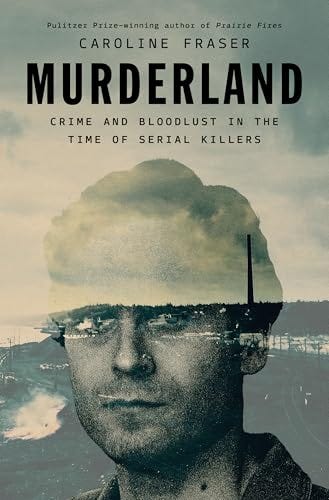Lead Poisoning and Ted Bundy
Book Review: Murderland by Caroline Fraser
Murderland: Crime and Bloodlust in the Time of Serial Killers by Caroline Fraser
Published: June 10, 2025 by Penguin Press
Buy this book at: Bookshop / Barnes & Noble / Kobo
Synopsis:
From the Pulitzer Prize-winning author of Prairie Fires comes a terrifying true-crime history of serial killers in the Pacific Northwest—a gripping investigation of how a new strain of psychopath emerged out of a toxic landscape of deadly industrial violence.
Caroline Fraser grew up in the shadow of Ted Bundy, the most notorious serial murderer of women in American history, surrounded by his hunting grounds and mountain body dumps, in the brooding landscape of the Pacific Northwest. But in the 1970s and 80s, Bundy was just one perpetrator amid an uncanny explosion of serial rape and murder across the region. Why so many? Why so weirdly and nightmarishly gruesome? Why the senseless rise and then sudden fall of an epidemic of serial killing?
As Murderland indelibly maps the lives and careers of Bundy and his infamous peers in mayhem—the Green River Killer, the I-5 Killer, the Night Stalker, the Hillside Strangler, even Charles Manson—Fraser's Northwestern death trip begins to uncover a deeper mystery and an overlapping pattern of environmental destruction. At ground zero in Ted Bundy's Tacoma, stood one of the most poisonous lead, copper, and arsenic smelters in the world, but it was only one among many that dotted the area.
As Fraser's investigation inexorably proceeds, evidence mounts that the plumes of western smelters not only sickened and blighted millions of lives, but also warped young minds, spawning a generation of serial killers.
Rating:
Review:
I sought out this book after hearing an interview with the author. She presented the information so well that I was fascinated. Having spent a few years living in the same places that Ted Bundy used to haunt, I was intrigued. Of course, I had heard of the Pacific Northwest and its abundance of serial killers. It really is quite remarkable. Even today the legend of the area persists. So I was intrigued by the idea that some of those monsters may have been spawned by the advancing of technology.
The idea of chemical agents affecting brain chemistry is nothing new. From Thalidomide causing birth defects to more than 10,000 children in the 1950s to the widespread use of DDT that cause absolutely catastrophe for wildlife and humans alike. There have been many instances of companies exposing the public to things that end up poisoning us in horrific ways. This is just a fact of history. And there are some facts that make Fraser’s premise really interesting. The rise of the use of lead and arsenic in manufacturing skyrocketed almost in tandem with the skyrocketing of serial killers throughout the 60s, 70s and 80s. And the subsequent limiting of lead and arsenic in manufacturing also correlates with the reduction in the number of serial killers. But, of course, the first rule in science is that correlation does not necessarily equate causation. However, it definitely indicates an area that should be investigated.
Unfortunately, while this book had an intriguing premise, it was also a book having an identity crisis. Fraser jumps around so much that it’s difficult to stay focused on the content of the book. We spend an inordinate amount of time talking about bridges. The whole first section of the book is about the history of bridges on Lake Washington. Now, I understand the point she was trying to make. The bridges are symbolic of the rise of manufacturing in that area of Washington. But we talked about it for a LONG time. It was dull. I was bored.
Then we move on to some biographical history of Ted Bundy. Then it jumps to a personal memoir and stories of Fraser’s childhood in the area. While I understand why her childhood is relevant to her (one of Bundy’s victims was found just a mile from her grandmother’s house), it didn’t really belong in this book. All of the asides for a personal memoir were distracting. They had nothing to do with the rest of the book.
Out of a sixteen hour audiobook I made it to hour 10, and then I stopped. I couldn’t do it anymore. The memoir bits were boring. I was tired of hearing endlessly about bridges. While I loved the biographical bits about serial killers that wasn’t what the book was supposed to be about. This wasn’t a biography. In the end, it felt like we spent very little time talking about the actual premise that Fraser promised. I am no closer to finding out what evidence exists for her hypothesis.



